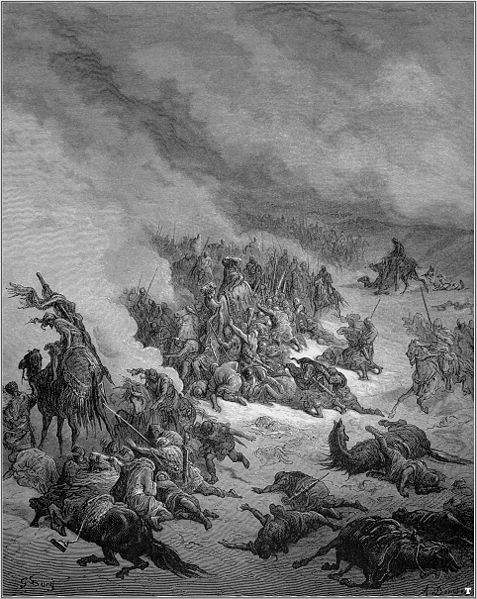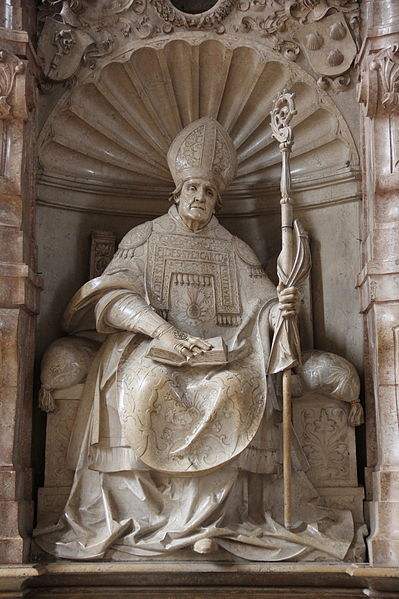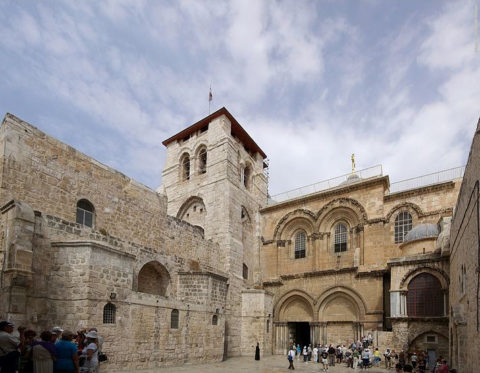 The Crusades were expeditions undertaken, in fulfilment of a solemn vow, to deliver the Holy Places from Mohammedan tyranny.
The Crusades were expeditions undertaken, in fulfilment of a solemn vow, to deliver the Holy Places from Mohammedan tyranny.
The origin of the word may be traced to the cross made of cloth and worn as a badge on the outer garment of those who took part in these enterprises. Medieval writers use the terms crux (pro cruce transmarina, Charter of 1284, cited by Du Cange s.v. crux), croisement (Joinville), croiserie (Monstrelet), etc.
Since the Middle Ages the meaning of the word crusade has been extended to include all wars undertaken in pursuance of a vow, and directed against infidels, i.e. against Mohammedans, pagans, heretics, or those under the ban of excommunication. The wars waged by the Spaniards against the Moors constituted a continual crusade from the eleventh to the sixteenth century; in the north of Europe crusades were organized against the Prussians and Lithuanians; the extermination of the Albigensian heresy was due to a crusade, and, in the thirteenth century the popes preached crusades against John Lackland and Frederick II. But modern literature has abused the word by applying it to all wars of a religious character, as, for instance, the expedition of Heraclius against the Persians in the seventh century and the conquest of Saxony by Charlemagne.
The idea of the crusade corresponds to a political conception which was realized in Christendom only from the eleventh to the fifteenth century; this supposes a union of all peoples and sovereigns under the direction of the popes. All crusades were announced by preaching. After pronouncing a solemn vow, each warrior received a cross from the hands of the pope or his legates, and was thenceforth considered a soldier of the Church. Crusaders were also granted indulgences and temporal privileges, such as exemption from civil jurisdiction, inviolability of persons or lands, etc. Of all these wars undertaken in the name of Christendom, the most important were the Eastern Crusades, which are the only ones treated in this article.
DIVISION
It has been customary to describe the Crusades as eight in number:
- the first, 1095-1101;
- the second, headed by Louis VII, 1145-47;
- the third, conducted by Philip Augustus and Richard Coeur-de-Lion, 1188-92;
- the fourth, during which Constantinople was taken, 1204;
- the fifth, which included the conquest of Damietta, 1217;
- the sixth, in which Frederick II took part (1228-29); also Thibaud de Champagne and Richard of Cornwall (1239);
- the seventh, led by St. Louis, 1249-52;
- the eighth, also under St. Louis, 1270.
This division is arbitrary and excludes many important expeditions, among them those of the fourteenth and fifteenth centuries. In reality the Crusades continued until the end of the seventeenth century, the crusade of Lepanto occurring in 1571, that of Hungary in 1664, and the crusade of the Duke of Burgundy to Candia, in 1669. A more scientific division is based on the history of the Christian settlements in the East; therefore the subject will be considered in the following order:
II. Foundation of Christian states in the East;
III. First destruction of the Christian states (1144-87);
IV. Attempts to restore the Christian states and the crusade against Saint-Jean d’Acre (1192-98);
V. The crusade against Constantinople (1204);
VI. The thirteenth-century crusades (1217-52);
VII. Final loss of the Christian colonies of the East (1254-91);
VIII. The fourteenth-century crusade and the Ottoman invasion;
I. ORIGIN OF THE CRUSADES
The origin of the Crusades is directly traceable to the moral and political condition of Western Christendom in the eleventh century. At that time Europe was divided into numerous states whose sovereigns were absorbed in tedious and petty territorial disputes while the emperor, in theory the temporal head of Christendom, was wasting his strength in the quarrel over Investitures. The popes alone had maintained a just estimate of Christian unity; they realized to what extent the interests of Europe were threatened by the Byzantine Empire and the Mohammedan tribes, and they alone had a foreign policy whose traditions were formed under Leo IX and Gregory VII. The reform effected in the Church and the papacy through the influence of the monks of Cluny had increased the prestige of the Roman pontiff in the eyes of all Christian nations; hence none but the pope could inaugurate the international movement that culminated in the Crusades. But despite his eminent authority the pope could never have persuaded the Western peoples to arm themselves for the conquest of the Holy Land had not the immemorial relations between Syria and the West favoured his design. Europeans listened to the voice of Urban II because their own inclination and historic traditions impelled them towards the Holy Sepulchre.
From the end of the fifth century there had been no break in their intercourse with the Orient. In the early Christian period colonies of Syrians had introduced the religious ideas, art, and culture of the East into the large cities of Gaul and Italy. The Western Christians in turn journeyed in large numbers to Syria, Palestine, and Egypt, either to visit the Holy Places or to follow the ascetic life among the monks of the Thebaid or Sinai. There is still extant the itinerary of a pilgrimage from Bordeaux to Jerusalem, dated 333; in 385 St. Jerome and St. Paula founded the first Latin monasteries at Bethlehem. Even the Barbarian invasion did not seem to dampen the ardour for pilgrimages to the East. The Itinerary of St. Silvia (Etheria) shows the organization of these expeditions, which were directed by clerics and escorted by armed troops. In the year 600, St. Gregory the Great had a hospice erected in Jerusalem for the accommodation of pilgrims, sent alms to the monks of Mount Sinai (“Vita Gregorii” in “Acta SS.”, March 11, 132), and, although the deplorable condition of Eastern Christendom after the Arab invasion rendered this intercourse more difficult, it did not by any means cease.
As early as the eighth century Anglo-Saxons underwent the greatest hardships to visit Jerusalem. The journey of St. Willibald, Bishop of Eichstädt, took seven years (722-29) and furnishes an idea of the varied and severe trials to which pilgrims were subject (Itiner. Latina, 1, 241-283). After their conquest of the West, the Carolingians endeavoured to improve the condition of the Latins settled in the East; in 762 Pepin the Short entered into negotiations with the Caliph of Bagdad. In Rome, on 30 November, 800, the very day on which Leo III invoked the arbitration of Charlemagne, ambassadors from Haroun al-Raschid delivered to the King of the Franks the keys of the Holy Sepulchre, the banner of Jersualem, and some precious relics (Einhard, “Annales”, ad an. 800, in “Mon. Germ. Hist.: Script.”, I, 187); this was an acknowledgment of the Frankish protectorate over the Christians of Jerusalem. That churches and monasteries were built at Charlemagne’s expense is attested by a sort of a census of the monasteries of Jerusalem dated 808 (“Commemoratio de Casis Dei” in “Itiner. Hieros.”, I, 209). In 870, at the time of the pilgrimage of Bernard the Monk (Itiner. Hierosol., I, 314), these institutions were still very prosperous, and it has been abundantly proved that alms were sent regularly from the West to the Holy Land. In the tenth century, just when the political and social order of Europe was most troubled, knights, bishops, and abbots, actuated by devotion and a taste for adventure, were wont to visit Jerusalem and pray at the Holy Sepulchre without being molested by the Mohammedans. Suddenly, in 1009, Hakem, the Fatimite Caliph of Egypt, in a fit of madness ordered the destruction of the Holy Sepulchre and all the Christian establishments in Jerusalem. For years thereafter Christians were cruelly persecuted. (See the recital of an eyewitness, Iahja of Antioch, in Schlumberger’s “Epopée byzantine”, II, 442.) In 1027 the Frankish protectorate was overthrown and replaced by that of the Byzantine emperors, to whose diplomacy was due the reconstruction of the Holy Sepulchre. The Christian quarter was even surrounded by a wall, and some Amalfi merchants, vassals of the Greek emperors, built hospices in Jerusalem for pilgrims, e.g. the Hospital of St. John, cradle of the Order of Hospitallers.
Instead of diminishing, the enthusiasm of Western Christians for the pilgrimage to Jerusalem seemed rather to increase during the eleventh century. Not only princes, bishops, and knights, but even men and women of the humbler classes undertook the holy journey (Radulphus Glaber, IV, vi). Whole armies of pilgrims traversed Europe, and in the valley of the Danube hospices were established where they could replenish their provisions. In 1026 Richard, Abbot of Saint-Vannes, led 700 pilgrims into Palestine at the expense of Richard II, Duke of Normandy. In 1065 over 12,000 Germans who had crossed Europe under the command of Günther, Bishop of Bamberg, while on their way through Palestine had to seek shelter in a ruined fortress, where they defended themselves against a troop of Bedouins (Lambert of Hersfeld, in “Mon. Germ. Hist.: Script.”, V, 168). Thus it is evident that at the close of the eleventh century the route to Palestine was familiar enough to Western Christians who looked upon the Holy Sepulchre as the most venerable of relics and were ready to brave any peril in order to visit it. The memory of Charlemagne’s protectorate still lived, and a trace of it is to be found in the medieval legend of this emperor’s journey to Palestine (Gaston Paris in “Romania”, 1880, p. 23).
The rise of the Seljukian Turks, however, compromised the safety of pilgrims and even threatened the independence of the Byzantine Empire and of all Christendom. In 1070 Jerusalem was taken, and in 1091 Diogenes, the Greek emperor, was defeated and made captive at Mantzikert. Asia Minor and all of Syria became the prey of the Turks. Antioch succumbed in 1084, and by 1092 not one of the great metropolitan sees of Asia remained in the possession of the Christians. Although separated from the communion of Rome since the schism of Michael Cærularius (1054), the emperors of Constantinople implored the assistance of the popes; in 1073 letters were exchanged on the subject between Michael VII and Gregory VII. The pope seriously contemplated leading a force of 50,000 men to the East in order to re-establish Christian unity, repulse the Turks, and rescue the Holy Sepulchre. But the idea of the crusade constituted only a part of this magnificent plan. (The letters of Gregory VII are in P.L., CXLVIII, 300, 325, 329, 386; cf. Riant’s critical discussion in Archives de l’Orient Latin, I, 56.) The conflict over the Investitures in 1076 compelled the pope to abandon his projects; the Emperors Nicephorus Botaniates and Alexius Comnenus were unfavourable to a religious union with Rome; finally war broke out between the Byzantine Empire and the Normans of the Two Sicilies.
It was Pope Urban II who took up the plans of Gregory VII and gave them more definite shape. A letter from Alexius Comnenus to Robert, Count of Flanders, recorded by the chroniclers, Guibert de Nogent (“Historiens Occidentaux des Croisades”, ed. by the Académie des Inscriptions, IV, 13l) and Hugues de Fleury (in “Mon. Germ. Hist.: Script.”, IX, 392), seems to imply that the crusade was instigated by the Byzantine emperor, but this has been proved false (Chalandon, Essai sur le règne d’Alexis Comnène, appendix), Alexius having merely sought to enroll five hundred Flemish knights in the imperial army (Anna Comnena, Alexiad., VII, iv). The honour of initiating the crusade has also been attributed to Peter the Hermit, a recluse of Picardy, who, after a pilgrimage to Jerusalem and a vision in the church of the Holy Sepulchre, went to Urban II and was commissioned by him to preach the crusade. However, though eyewitnesses of the crusade mention his preaching, they do not ascribe to him the all-important rôle assigned him later by various chroniclers, e.g. Albert of Aix and especially William of Tyre. (See Hagenmeyer, Peter der Eremite Leipzig, 1879.) The idea of the crusade is chiefly attributed to Pope Urban II (1095), and the motives that actuated him are clearly set forth by his contemporaries: “On beholding the enormous injury that all, clergy or people, brought upon the Christian Faith . . . at the news that the Rumanian provinces had been taken from the Christians by the Turks, moved with compassion and impelled by the love of God, he crossed the mountains and descended into Gaul” (Foucher de Chartres, I, in “Histoire des Crois.”, III, 321). Of course it is possible that in order to swell his forces, Alexius Comnenus solicited assistance in the West; however, it was not he but the pope who agitated the great movement which filled the Greeks with anxiety and terror.
LOUIS BRÉHIER (Catholic Encyclopedia)
II. Foundation of Christian states in the East;













